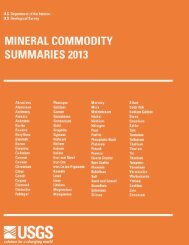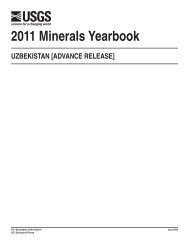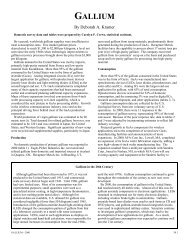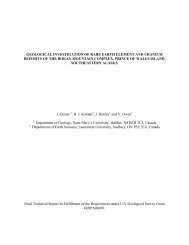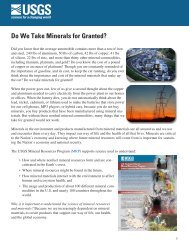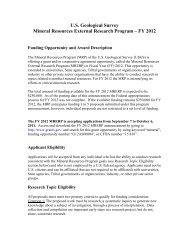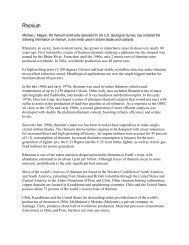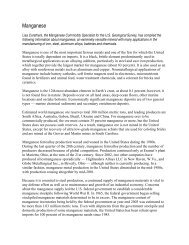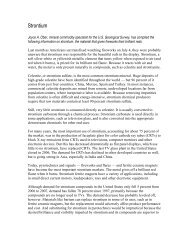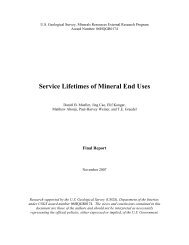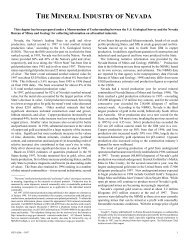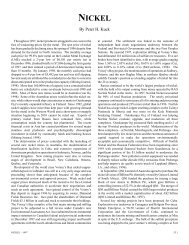Mineral Commodity Summaries 2003 - Mineral Resources Program ...
Mineral Commodity Summaries 2003 - Mineral Resources Program ...
Mineral Commodity Summaries 2003 - Mineral Resources Program ...
You also want an ePaper? Increase the reach of your titles
YUMPU automatically turns print PDFs into web optimized ePapers that Google loves.
PLATINUM-GROUP METALS<br />
Events, Trends, and Issues: During the first 9 months of 2002, the average price of PGM returned to more<br />
traditional levels. Palladium’s rise to more than $1,000 per ounce during 2000 prompted the substitution of silver and<br />
base metals along with a reduction in the palladium content of its major end-use applications. Lower consumption by<br />
automobile manufacturers, a slowdown in the electronics sector, and increased production by Russia and South Africa<br />
caused palladium prices to fall to about $450 per ounce by September 2001 and to $330 per ounce in September<br />
2002. Lower demand by the automobile industry and the slumping global economy caused platinum prices to fall but<br />
not nearly as precipitously as prices for palladium. Ruthenium was able to sustain its $130 per ounce price (up from<br />
$40 per ounce) through September 2001, but eventually fell back to $60 per ounce in September 2002. Russia<br />
accounted for more than 45% of U.S. palladium supply and about 5% of U.S. platinum supply in 2002. Higher PGM<br />
prices in 2000-01 were followed by an increase in the pace of exploration for PGM, and a growing number of joint<br />
ventures were signed in recognition of the strong fundamentals for these metals. Exploration activities continued<br />
despite lower prices. Most producers think that developing technology, such as fuel cells, will eventually increase<br />
demand for these metals.<br />
World Mine Production, Reserves, and Reserve Base:<br />
Mine production PGM<br />
Platinum Palladium Reserves 4 Reserve base 4<br />
2001 2002 e<br />
2001 2002 e<br />
United States 3,610 3,900 12,100 13,000 900,000 2,000,000<br />
Canada 5,500 7,000 8,800 11,000 310,000 390,000<br />
Russia 29,000 29,000 90,000 99,500 6,200,000 6,600,000<br />
South Africa 120,000 126,000 61,000 59,900 63,000,000 70,000,000<br />
Other countries 2,000 5,400 7,400 10,000 800,000 850,000<br />
World total (rounded) 160,000 171,000 179,000 193,000 71,000,000 80,000,000<br />
World <strong>Resources</strong>: World resources of PGM in mineral concentrations that can be mined economically are estimated<br />
to total more than 100 million kilograms. The largest reserves are in the Bushveld Complex in South Africa. In 2002,<br />
there were 10 producing mines in the Bushveld Complex; of these, 9 produced from the Merensky Reef and UG2<br />
Chromite Layer and 1 produced from the Platreef, on the northern limb of the Complex.<br />
Substitutes: Some motor vehicle manufacturers have substituted platinum for the more expensive palladium in<br />
catalytic converters. In addition, electronic parts manufacturers are reducing the average palladium content of the<br />
conductive pastes used to form the electrodes of multilayer ceramic capacitors by substituting base metals or silverpalladium<br />
pastes that contain significantly less palladium.<br />
e Estimated. — Zero.<br />
1 Estimates from published sources.<br />
2 Handy & Harman quotations.<br />
3 See Appendix B for definitions.<br />
4 See Appendix C for definitions.<br />
127<br />
U.S. Geological Survey, <strong>Mineral</strong> <strong>Commodity</strong> <strong>Summaries</strong>, January <strong>2003</strong>



